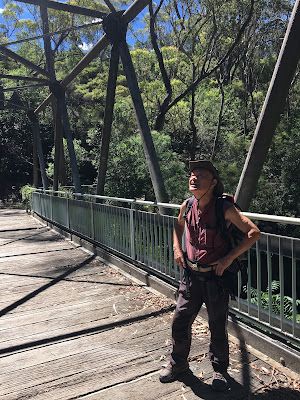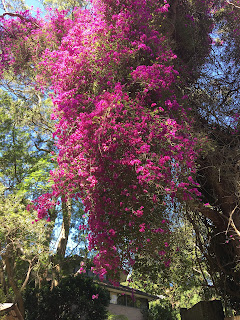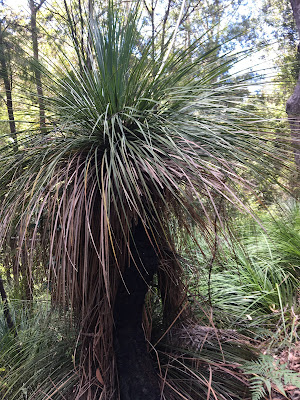SR 41 "Bougainvillea and Giant Pine Cone" "Revenge Walk: GNW # 7 and #8 (From Hornsby to Mt. Kuring-gai via Galston Gorge"
"Bougainvillea and Giant Pine Cone"
I do relatively big trekking with Korean hikers such as Blue Mountains twice a week (Tuesday and Saturday). On other days, I walk almost the same course in the local park every day.
The area is Chatswood West and the name of the park is Ferndale Park. The park connects Chatswood Station to the Lane Cove River, a river that runs through the Lane Cove National Park, and has many tracks in the rainforest.
One of them is the entrance that looks like “no through road” and is my favorite course.
Standing at this entrance, many pink flowers are blooming like a waterfall from the height of a 6-story building. Looking at the ground, many petals are falling all over the road. They are bougainvillea.
>
[The giant bougainvillea,巨大なブーゲンビリア、거대한 부겐빌레아]
Bougainvillea is a genus of thorny ornamental vines, bushes, and trees belonging to the four o' clock family, Nyctaginaceae. It is native to eastern South America, found from Brazil, west to Peru, and south to southern Argentina. Different authors accept from 4 to 18 species in the genus. The inflorescence consists of large colorful sepal-like bracts which surround three simple waxy flowers.(From Wikipedia.)
[Many follen bracts on the road, 道路に落ちた包葉、도로에 떨어진 포엽]
This bougainvillea is as large as a 6-story building of flowers and there are many bracts fallen on the road, just like a colorful carpet.
[Bougainvillea flowers and bracts,ブーゲンビリアの花と苞葉、부겐빌레아 꽃과 포엽]
The bougainvillea is creeping around a tall tree on the left side. And there is another tall tree just before the bougainvillea. It is a Bunya Pine which bears huge pine cones.
[Bunya Pine tree, バンヤ・パイン(ヒロハナンヨウスギ),버냐소나무]
When I saw the pine cones for the first time, I was really surprised. They are as large as big sized watermelons.
I brought one of them to our share house and measured it. It was 4.5kg! If it hits a passer-by, it may kill the person. I’ll say it is dangerous.
[Huge pine cones (Bunya pine cones0,巨大な松ぼっくり、거대한 솔방울(열매)]
[Noah (my grandson) holds Bunya Pine Cone,バンヤ・パインの実を持つ孫、버냐 소나무의 열매를 들고있는 손자]
In addition, the cracked pine cones contain pine nuts that are 3 to 4 cm in size. It can be eaten raw and is delicious when baked or boiled in salt. It tastes like a savory chestnut.
[Broken Bunya Pine Cone,割れたバンヤ・パインの実、깨진 버냐 소나무의 열매]
By the way, Banya Pine is a living fossil plant that has existed since the Jurassic period (213.5 million to about 145.5 million years ago) when dinosaurs prospered, and dinosaurs may have eaten this fruit as well.
[Bunya Pine nuts (about 100 from one cone),1個の実から100個の種、1개의 열매에서 100개의 씨]
[Bunya Pine nuts,バンヤパインの実、버냐 소나무의 열매]
In Queensland, north of NSW, there is a park called Bunya Mountains National Park, where Bunya Pines grow naturally.
"Revenge Walk: GNW # 7-8"
The Great North Walk (GNW) is a 260km track that connects Sydney to Newcastle. There are 30 sections suitable for a day trip, and there is no public access between # 7 and # 8, so we have to walk in one day at a stretch.
On August 11th, the year before last (2020), my trekking friend, Isaac and I walked on these tracks for the first time. But we repeated lost trails, and we could not reach the destination before sunset. Worse that our battery of the headlights ran out and lost our ways and walked through bush in the dark. Fortunately the ordeal ended within 30 minutes and we came out of the bush and arrived at Berowra, which was a wrong destination.
The outline of the official courses are as follows.
GNW # 7 Hornsby-Galston Gorge 9.7 km / 4 hrs / ↑ 473m Hard Track
GNW # 8 Galston Gorge-Mount Ku-ring-gai 12.6 km / 5.5 hrs / ↑ 846 m Hard Track
GNW # 7 + # 8: 22.3 km / 9 hrs 30 min./↑473m/↑846m Hard Track
By the way, ↑ is the height difference of the truck.
On August 11, 2020, we left Hornsby at 8:30 and arrived at our (wrong) destination of Berowra at 7:00 pm, so we walked for 10 hours and 30 minutes. However, we had a hard time because the season was winter and the sunset was around 5 o'clock.
This time (December 31, 2021), we left at 9 o'clock and arrived at the (right) destination of Mt. Kuring-gai at 5:30 pm. The walking time was 8 hours and 30 minutes, which was one hour shorter than the standard time. It can be said that our “revenge” was successful.
I will explain the outline of each main section as follows:
[Hornsby Station-Berowra Valley Bushland Park]
The Hornsby station and town are on the Highlands. There is a nice park with a 50-meter swimming pool near the station. There are signs of GNW before the park. If you follow the signs, looking the park on your right side, while paying attention to the motorcycle-only road, you will see a GNW sign and you will soon be on a downhill slope.
[A GNW sign at a junction, 分岐点のGNWの標識、분기점 GNW 표지]
Down this staircase you will reach Berowra Valley Bushland Park, which also has barbecue facilities. Christmas decorations were still installed here that day.
[A Chirstmas decoration at the park, 公園内のクリスマスの飾り、공원에 있는 크리스마스 장식]
[From Berowra Valley Bushland Park to Fishponds Junction]
This is a wide and comfortable road like a fire track with a forest of blue gum trees. This part overlaps with the "Blue Gum Truck". You can see huge rocks in the airy forest.
[A woods of blue gum trees,ブルーガム・トリーの林、블루검 트리의 숲]
There is a sign at the end of the branch from this track, and there is a branch sign with Fishponds, and when you turn right, you will see a steep uphill slope. At the top of the 95m zigzag staircase is a steel staircase, which leads to a highland residential area.
[A sign board at the junction, 分岐点の標識板、분기점 표지판]
[From residential area to the track-head of Clarinda St.]
There are GNW signs at key points in this section, so you can easily proceed. At the end of Clarinda Street at the end of the road, there is a large sign for "Berowra Valley Regional Park", which is followed by a wide road like a fire trail.
[From Clarinda Street to Steel Bridge]
At the first time in August 2020, we overlooked the left turn sign in the middle of this wide fire trail and went straight, so we ended up walking on the motorway and arrived at Galston Gorge by relying on GPS.
This time, we confirmed the sign we had overlooked last time and continued the bushwalk. Then a unique Steel Bridge appeared on the way. Berowra Creek runs below, and according the web information, there are only four bridges of this type in NSW. It was completed in 1965. The purpose of the bridge is to allow fire trucks to pass through.
[At the sign we mised last time, 前回見落とした標識にて、지난 번 간과한 표지에서]
[Galston Gorge from Steel Bridge]
Cross the Steel Bridge and follow a gentle uphill, follow the GNW signs and you will see a sign on the way to the bush trail. If you don't miss this, the Galston Gorge at the end of the 7th section of the GNW is near. There are iron handles and stairs on the trail that goes down from the top of the cliff to the bottom of the valley. You can go down at once.
[At the steel bridge, スティール・ブリッジにて、스틸 브리지에서]
The Galston Gorge has concrete stepping stones, but it is dangerous to cross the gorge during or after heavy rainfall. We could pass safely and arrived at 12:05 at the bench there. This is the destination of GNW # 7. It took about 3 hours this time.
[The trail at Galston Gorge、ガルストンゴージの登山路、가르스톤 고지의 등산로]
The Galston Gorge has benches suitable for breaks, but the best in the shade had been occupied by a boy for fishing, waiting for his family car so we took a break and ate separately at Galston Gorge.
[The sign board at Galston Gorge,ガルストン・ゴージのGNW標識、가르스톤 고지의 GNW 표지판]
[From Galston Gorge to Crosslands]
We left Galston Gorge at 12:40. From this point it is GNW #8. We walked on the track along the Berowra Creek which leads to Berowra Waters. We had to cross many small creeks which flow in the Berowra Creek.
[The trail to Crosslands, クロスランドへの道、크로스랜드로 향하는 등산로]
You may easily lose the way when you cross creeks. We experienced several times when we walked this course for the first time. Any way this part of the section, you go up and down many times.
Then we came to the wide flat area called Crosslands. This is a wide picnic area with camping facilities including drinking water and public toilets. Since it was a school holiday, there were many families and campers. There are spacious parking lots as well.
[Berowra Creek at Crosslands,クロスランド付近のベロウラ・クリーク、크로스랜드 근처의 벨로우라 크릭]
[Berowra Creek at Crosslands,クロスランド付近のベロウラ・クリーク、크로스랜드 근처의 벨로우라 크릭]
[From Crosslands to Mount Kuring-gai Station]
A short walk along Berowra Creek from Crossland, you will reach a three-way junction across Calna Creek. This part is a wetland and it reminds me of Ozegahara (尾瀬ヶ原) in Japan, and if you proceed toward the wetland on your left, you will reach Berowra along Berowra Creek, followed by GNW # 9. Turn right to reach your destination, Mount Kuring-gai.
[The wet land reminds me of Oze,尾瀬を思い出す湿原、오세를 생각나게 하는 습지]
The last time failure was that we turned left here. This time, we definitely turned right and followed Calna Creek to Lyrebird Gulley.
[At the bridge over Calna Creek, カルナ・クリークにかかる橋の上で、카르나 크릭에 걸쳐있는 다리에서]
This course also goes up and down the track with a large height difference, but the remarkable place is the hollow of the huge rock called Lyrebird Cave and the Lyrebird Waterfall beyond it.
[At Lyrebird Cave,ライヤーバード・ケーブにて、라이어 버드 동굴에서]
The latter is a waterfall of 5 to 6 meters, with the water of the river passing through several holes like smooth sculptures of water carving the bottom of a huge rock.
[A waterfall in Lyrebird Gulley, ライヤーバード渓谷の滝、라이어버드 계곡 폭포]
There are GNW signs at the key points in this section, but it is easy to get lost because the mountain trail is difficult to identify due to driftwood etc. in the part that straddles the creek. Once again, it was not clear where I crossed the creek, so I searched for a mountain trail with two companions looking for a sign.
It's a relief to get out on the road leading to the familiar track head that I walked several times. We arrived at the station of Mount Ku-ring-gai at 17:30.
[Comparison between Mount Solitary (1) and this revenge walk (2)]
Walking time/walking distance/number of steps/number of floors
(1) 6.5 hours / 28.4km / 39,354 steps 58th floor
(2) 8.5 hours / 34.1km / 48,313 steps 180th floor
Obviously, the exercise intensity was higher this time, but unlike (1) there was no cramping in both legs or pain in the legs over the next day this time (1).
In short, it is important to walk at your own pace and with enough time. From this, I feel that I would like to challeng Mount Solitary Walk again in the near future (during daylight saving time.)
-------------------------------------------------------------------------------------
SR 41号 「ブーゲンビリアと巨大松ボックリ」「リベンジ・ウォーク:GNW#7+8(ホーンズビーからガルストンゴージ経由マウント・クーリンガイ)」
「ブーゲンビリアと巨大松ボックリ」
私は週二回(火曜日と土曜日)、ブルーマウンテンなど韓国人のハイカーたちと比較的大きなトレッキングをする。その他の日は毎日地元の公園内のほぼ同じコースを歩く
。
地域はチャッツウッド・ウェストであり、公園の名はファンデール・パークという。この公園はチャッツウッド駅からレインコーブ・リバーというレインコーブ国立公園内を流れる川を結ぶ地域で、熱帯雨林の中に多くのトラックがある。
そのうちの1つが袋小路のように見える入り口で私が一番気に入っているコースである。
この入り口に立つと6階建てのビルほどの高さからたくさんのピンクの花が滝のように咲いている。地面をみるとたくさんの花びらが道路一面に落ちている。これはブーゲンビリアである。
[The giant bougainvillea,巨大なブーゲンビリア、거대한 부겐빌레아]
ウィキペディアをみると「ブーゲンビリア(Bougainvillea)は、オシロイバナ科ブーゲンビリア属に属する熱帯性の低木である。和名はイカダカズラ(筏葛)、ココノエカズラ(九重葛)である。」となっているが、ここのブーゲンビリアは道路の横の大木にからまって、それこそ6階建ての花のビルのようだ。
[Many follen bracts on the road, 道路に落ちた包葉、도로에 떨어진 포엽]
色づいた花びらに見える部分は花を取り巻く葉(包葉ほうよう)ということで、この包葉が一面に敷き詰めたようにみえる。
[Bougainvillea flowers and bracts,ブーゲンビリアの花と苞葉、부겐빌레아 꽃과 포엽]
今週、この苞葉のじゅうたんの手前にスイカ大の濃い緑の塊がゴロゴロ転がっている。よく見ると巨大な松ぼっくりである。
ブーゲンビリアの先にそびえる高さ20mほどの大木はバンヤ・パイン(Bunya Pine)という。日本名はヒロハナンヨウスギ(広葉南洋杉)というらしい。[マツ綱 Pinopsida、マツ目Pinales、ナンヨウスギ科Araucariaceae]
[Bunya Pine tree, バンヤ・パイン(ヒロハナンヨウスギ),버냐 소나무]
この木の下には。5、6個のスイカのような巨大な「松ぼっくり」が道路上にゴロゴロしており、そのいくつかはコンクリートの道路に落下した衝撃で割れている。
[Broken Bunya Pine Cone,割れたバンヤ・パインの実、깨진 버냐 소나무의 열매]
ちなみに1個家へ持ち運んで体重計で測ってみると4.6 kgあった。これが通行人を直撃すれば、死亡事故になるのではないかと危惧される。
[Bunya Pine nuts,バンヤパインの種、버냐 소나무의 씨]
また、割れた松ぼっくりの中には3~4センチ大のマツの実が入っている。これは生でも食べれるし焼いたり塩ゆでにすると美味である。こうばしい栗の実のような味がする。
[Rice cooked with Bunya Nuts, バンヤナッツ炊き込みご飯、버냐넛 밥]
ちなみにバンヤ・パインは恐竜が栄えたジュラ紀(2億130万年~約1億4550万年前)から存在する生きた化石といわれる植物で恐竜もこの実をたべていたのかもしれない。
NSW州の北隣のクイーンズランド州にはバンヤ山脈国立公園(Bunya Mountains National Park)という公園があり、バンヤ・パインが自生している。
「リベンジ・ウォーク:GNW#7-8」
ザ・グレート・ノース・ウォーク(GNW)はシドニーからニューキャッスルまでを結ぶ260㎞のトラックである。これは日帰りに適した30区間にそれぞれの番号があり、#7と#8の中間は公共アクセスがなく、一気に1日で歩かなければならない。
一昨年(2020年)8月11日にわが山友アイザックと二人で試み、道迷いを繰り返し、日没過ぎにヘッドライトの電池も切れて暗闇の中をさんざんな思いをして生還したコースである。
公式コースの概要は以下のとおりである。
GNW#7 ホーンズビー~ガルストン・ゴージ
9.7 km/4 hrs/↑473m Hard Track
GNW#8 ガルストン・ゴージ~マウント・クーリンガイ
12.6 km/5.5 hrs/↑846m Hard Track
GNW #7+#8
22.3 km/9 hrs 30 min./↑473m/↑846m Hard Track
ちなみに↑はトラックの高低差である。
2020年8月11日は8時半に出発して(誤った)目的地に午後7時に到着したので10時間30分歩いた。ただし時期が冬で日没が5時頃であったため苦労した。
今回(2021年12月31日)は9時に出発して午後5時半に目的地に着いた。歩いた時間は8時間30分だから標準時間より1時間短かった。リベンジは成功したといえよう。
以下、主なセクションごと概要を説明する。
[ホーンズビー駅~ベロウラ・バリー・ブッシュランド・パーク]
ホーンズビーの駅および町はハイランドの上にある。駅前の公園(50mプールがある)を右に見て、バイク専用道路に気を付けながら進むとGNWの標識があり、すぐ石段の下り坂になる。この階段を下ったところがバーベキュー設備もそなえたベロウラ・バリー・ブッシュランド・パークに出る。ここにはクリスマスの飾りがまだ設置してあった。
[In front of the Xmas decoration, 公園内のクリスマスの装飾の前で、공원 내 크리스마스 장식 앞에서]
[ベロウラ・バリー・ブッシュランド・パークからフィッシュポンド分岐点]
ここはファイア・トラックのような広い快適な道でブルーガム・トリーの林がある。この部分は部分は「ブルーガム・トラック」と重なっている。風通しの良い林のなかに巨石がごろごろしている。
[A woods of blue gum trees,ブルーガム・トリーの林、블루검 트리의 숲]
このトラックから分岐して下った先に標識があり、さらにフィッシュポンドとの分岐標識があり、右折すると急こう配の上り坂となる。95mのつづら折りの階段の最上部はスチール階段で、ここを上りきるとハイランドの住宅街にでる。
[住宅街からクラリンダ・ストリートのGNWトラックヘッド]
[A GNW sign at a junction, 分岐点のGNWの標識、분기점 GNW 표지]
この区間はGNWの標識が要所要所にあり、楽に歩みを進められる。道路歩きの末のClarinda Streetの終点のトラックヘッドには「Berowra Valley Regional Park」の大きな看板があり、ファイア・トレイルのような広い道が続く。
[Isaac at the GNW board, GNWの標識板とアイザック、GNW 표지판과 아이작]
[クラリンダ・ストリートからスティール・ブリッジ]
2020年8月の第一回目の時、この広いファイア・トレイルの途中にある左折の標識を見落として直進したため、自動車道路を歩く羽目になり、GPSに頼ってガルストンゴージに到着した。
今回は前回見落とした標識を確認してブッシュウォークを続けた。するとユニークなスティール・ブリッジが行く手に現れた。下を流れるのはベロウラ・クリークで、このタイプの橋はNSW州で4か所だけ。完成は1965年ということだ。橋の目的は消防自動車が通れるようにするためだという。
[At the sign we mised last time, 前回見落とした標識にて、지난 번 간과한 표지에서]
[スティール・ブリッジからガルストンゴージ]
スティール・ブリッジを渡って緩やかな登り坂を進み、GNWの標識に従って進むと途中にブッシュ・トレイルに入る標識がある。これを見逃さなければGNWの第7セクションの終点のガルストンゴージは近い。崖の上から一気に谷底へ下るようなトレイルで鉄製の取っ手や階段もある。
[At the steel bridge, スティール・ブリッジにて、스틸 브리지에서]
ガルストンゴージにはコンクリート製のステッピング・ストーンがあるが、降雨が続いた増水時に渡るのは危険である。この日は無事に渡り、12:05に到着した。以上がGNW#7のコースである。この所用時間はほぼ3時間だった。
[The trail at Galston Gorge、ガルストンゴージの登山路、가르스톤 고지의 등산로]
ガルストンゴージには休憩に適したベンチがあるが、日陰で最適なものは釣りで家の車を待つ少年が占有していたため、我々は3人それぞれ別個に休憩して食事をとった。
[A grass tree at Galston Gorge,ガルストン・ゴージのグラス・ツリー、가르스톤 고지의 잔디 나무]
[ガルストンゴージからクロスランド]
ガルストン・ゴージを出発したのは12:40だった。ここから先はGNW#8である。
出だしはガルストン・ゴージからベロウラウォーターに続くかなり広い川に沿ってのトラックで、途中何か所も山から流れ込むクリークを越えなければならない。
[The trail to Crosslands, クロスランドへの道、크로스랜드로 향하는 등산로]
前回の道迷いの経験も生かし、特にクリーク越えの時には注意して迷わずに進めた。
クロスランドは広大なピクニックエリアであり、トイレ、バーベキュー、給水場、キャンプ場などがあり、また駐車場も完備していて多くの家族連れでにぎわっていた。
[Berowra Creek at Crosslands,クロスランド付近のベロウラ・クリーク、크로스랜드 근처의 벨로우라 크릭]
[クロスランドからマウント・クーリンガイ駅]
クロスランドからベロウラ・クリークに沿って少し進むとカルナ・クリークを渡った先が三叉路になっている。この部分は尾瀬ヶ原を連想させる湿地帯であり、左手の湿地帯のほうへ進めばベロウラ・クリークに沿ってベロウラへ達するGNWの#9に続く。右折すれば今回の目的地のマウント・クーリンガイに出る。
前回の失敗はここを左折してしまったことだ。今回はまちがいなく右折し、カルナ・クリーク(Calna Creek)に沿ってライヤーバード・ガリー(Lyrebird Gulley)を進む。
このコースも高低差の大きいトラックを上ったり、下ったりするが目覚ましい場所はライヤーバード・ケーブという巨岩のくぼみと、その先のライヤーバード・ウォーターフォールだ。
[Lyrebird Cave,ライヤーバード・ケーブ、라이어버드 동굴]
後者は川の水が巨岩の川底を水が彫ったなめらかな彫刻のようないくつかの穴を経て、5~6メートルの滝になっている。
この先も要所要所にGNWの標識があるが、クリークをまたぐ部分は登山路が流木などで分かりにくくなり、道迷いしがちだ。今回も1度クリークを渡った先が明確でなく、同行者二人と標識を目当てに登山路を探した。
[At Lyrebird Creek, ライヤーバード・クリークにて、라이어 버드 크릭에서]
何度か歩いた見覚えのあるトラックヘッドに続く道路に出て一安心である。17:30にはマウント・クーリンガイの駅に到着した。
[マウント・ソリタリー(1)と今回のリベンジ・ウォーク(2)の比較]
歩行時間 歩行距離 歩数 階数
(1) マウント・ソリタリー往復 6.5時間/ 28.4km/ 39,354歩 58階
(2) ホーンズビーからベロウラまで 5時間/ 34.1km/ 48,313歩 180階
明らかに今回のほうが運動強度が高かったが、マウント・ソリタリーの時のように両足が攣ったり翌日にわたる足の痛みなどはなかった。要はマイペースで余裕をもって歩くことが肝要である。このことから、日の長い間にマウント・ソリタリーも再度挑戦してみたい気がする。
I like hiking very much. I used to go hiking with a Korean hiking club named “AhToSan.” This blog introduces mostly my hiking activities in Korea and Japan, and Sydney in Australia. As of January 2020, I live in Sydney suburb. I go Blue Mountains and bush walk in Sydney area. 私は2003年から2014年まで韓国の大田(テジョン)に住んだ日本人である。11年間、週末は主に「アトサン山岳会」に参加した。14年4月に帰国したが、2020年以降はおもにシドニーで暮らし、時折、日本へ帰国する程度である。したがって最近の記事はSR(Sydney Report)としてブルーマウンテンのトレッキングを中心に書いている。
About pictures/当ブログ内の写真について/당 블로그내의 사진에 대해서
Most of the pictures in this blog are taken by my camera, yet some of them were downloaded from the website of the hiking club. If you click any pictures, they become the original size.
当ブログ内の写真の大部分は筆者のカメラで撮影したものですが、一部、山岳会の共有写真からダウンロードしたものを含みます。すべて、各写真をクリックすれば、元のサイズに拡大します。
당 블로그내 사진의 대부분은 필자의 카메라로 촬영한 것입니다만 일부 산악회 공유 사진으로부터 다운한 것도 포함합니다. 모두 각 사진을 클릭하면, 원래 사이즈에 확대합니다.
当ブログ内の写真の大部分は筆者のカメラで撮影したものですが、一部、山岳会の共有写真からダウンロードしたものを含みます。すべて、各写真をクリックすれば、元のサイズに拡大します。
당 블로그내 사진의 대부분은 필자의 카메라로 촬영한 것입니다만 일부 산악회 공유 사진으로부터 다운한 것도 포함합니다. 모두 각 사진을 클릭하면, 원래 사이즈에 확대합니다.










































